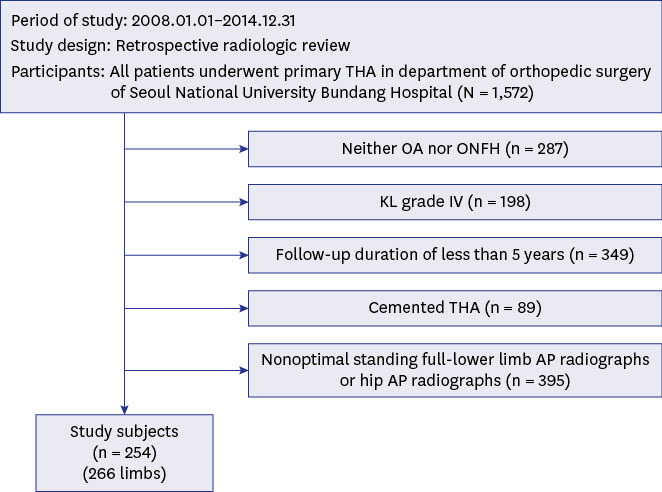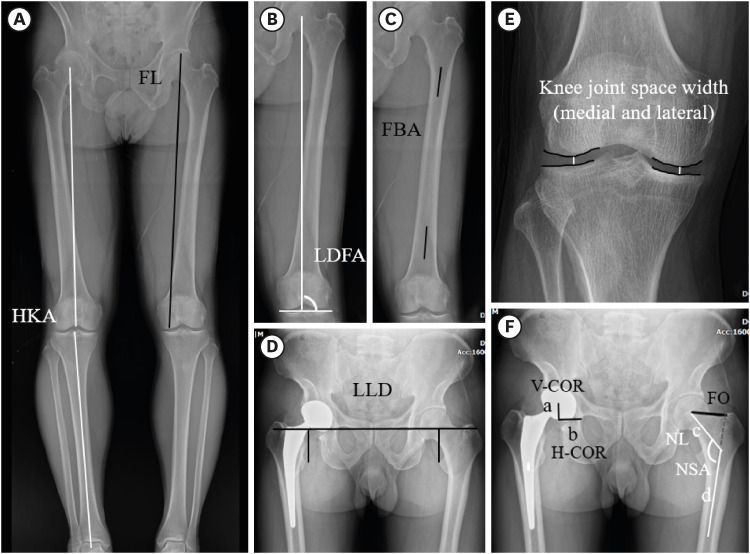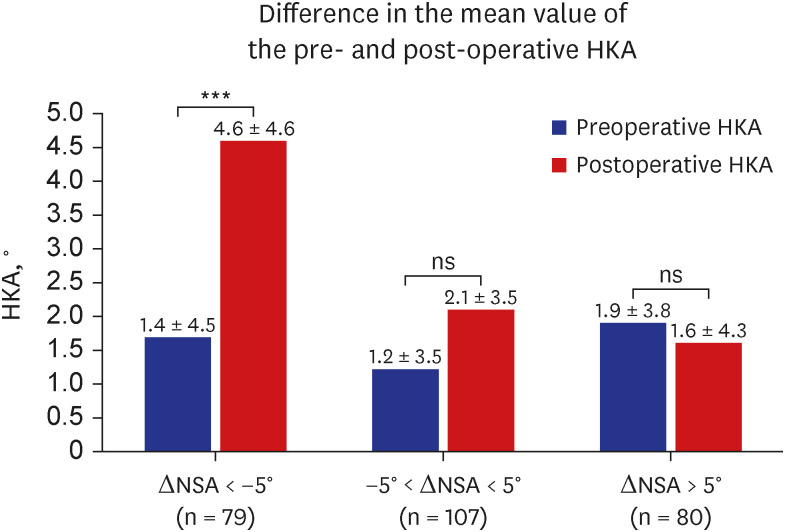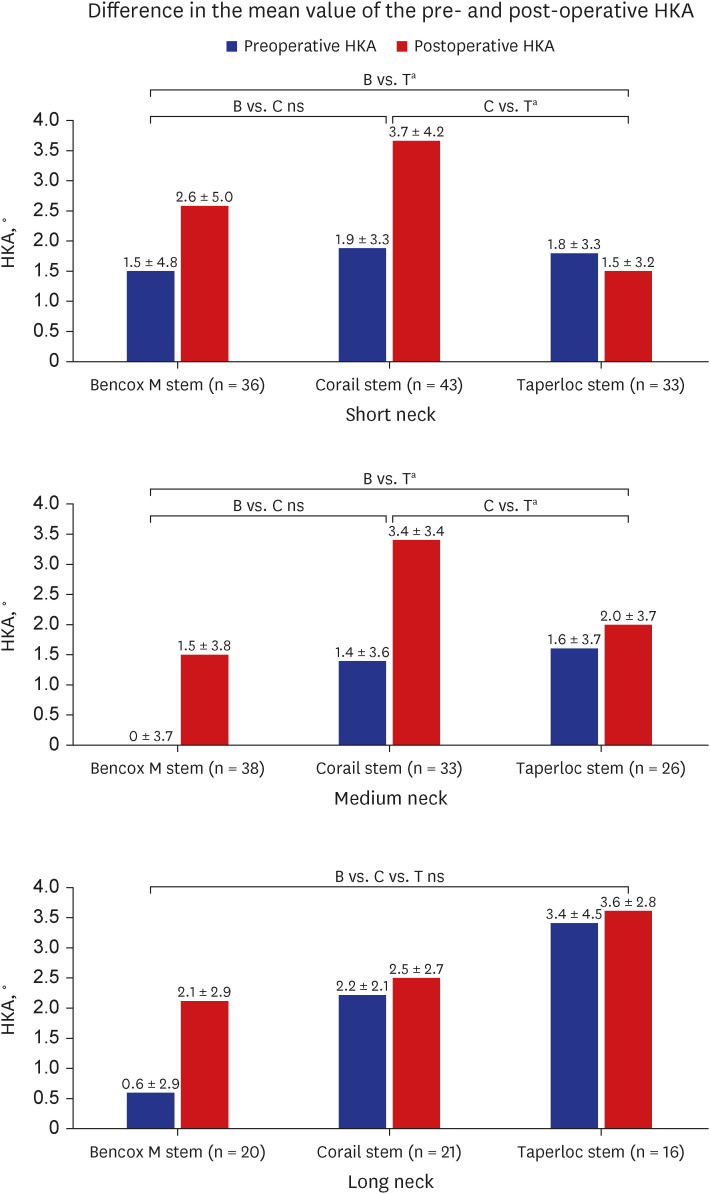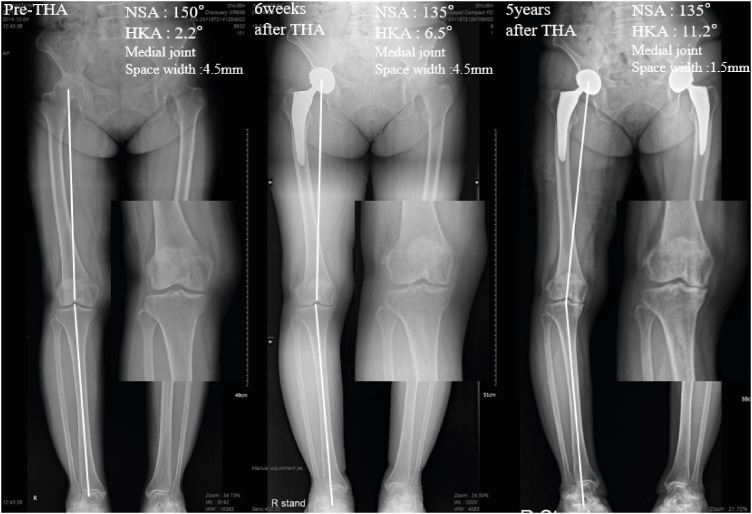J Korean Med Sci.
2023 May;38(20):e148. 10.3346/jkms.2023.38.e148.
Effect of Total Hip Arthroplasty on Ipsilateral Lower Limb Alignment and Knee Joint Space Width: Minimum 5-Year Follow-up
- Affiliations
-
- 1Department of Orthopaedic Surgery, Veterans Health Service Medical Center, Seoul, Korea
- 2Department of Orthopaedic Surgery, Seoul National University Bundang Hospital, Seongnam, Korea
- 3Department of Orthopaedic Surgery, Seoul National University Bundang Hospital, Seongnam, Korea
- 4Department of Orthopaedic Surgery, Seoul National University College of Medicine, Seoul, Korea
- 5Department of Orthopedic Surgery, Seoul National University Hospital, Seoul, Korea
- 6Kay Joint Center, Cheil Orthopaedic Hospital, Seoul, Korea
- KMID: 2542591
- DOI: http://doi.org/10.3346/jkms.2023.38.e148
Abstract
- Background
This study aimed to 1) assess the effect of total hip arthroplasty (THA) on coronal limb alignment, namely, the hip–knee–ankle angle (HKA), 2) identify factors that determine changes in the HKA, and 3) determine whether alignment changes influence the knee joint space width.
Methods
We retrospectively evaluated 266 limbs of patients who underwent THA. Three types of prostheses with neck shaft angles (NSAs) of 132°, 135°, and 138° were used. Several radiographic parameters were measured in the preoperative and final radiographs (at least 5 years after THA). A paired t-test was used to confirm the effect of THA on HKA change. Multiple regression analysis was performed to identify radiographic parameters related to HKA changes following THA and changes in knee joint space width. Subgroup analyses were performed to reveal the effect of NSA change on the HKA change, and the proportion of total knee arthroplasty usage and changes in radiographic parameters between maintained joint space and narrowed joint space groups were compared.
Results
The preoperative mean HKA was 1.4° varus and increased to 2.7° varus after THA. This change was related to changes in the NSA, lateral distal femoral angle, and femoral bowing angle. In particular, in the group with a decrease in NSA of > 5°, the preoperative mean HKA was largely changed from 1.4° varus to 4.6° varus after THA. The prostheses with NSA of 132° and 135° also led to greater varus HKA changes than those with an NSA of 138°. Narrowing of the medial knee joint space was related to changes in the varus direction of the HKA, decrease in NSA, increase in femoral offset.
Conclusion
A large reduction in NSA can lead to considerable varus limb alignment after THA, which can have adverse effects on the medial compartment of the ipsilateral knee.
Figure
Reference
-
1. Chang RW, Pellisier JM, Hazen GB. A cost-effectiveness analysis of total hip arthroplasty for osteoarthritis of the hip. JAMA. 1996; 275(11):858–865. PMID: 8596224.2. Graves SC, Dropkin BM, Keeney BJ, Lurie JD, Tomek IM. Does surgical approach affect patient-reported function after primary THA? Clin Orthop Relat Res. 2016; 474(4):971–981. PMID: 26620966.3. Rosenlund S, Broeng L, Jensen C, Holsgaard-Larsen A, Overgaard S. The effect of posterior and lateral approach on patient-reported outcome measures and physical function in patients with osteoarthritis, undergoing total hip replacement: a randomised controlled trial protocol. BMC Musculoskelet Disord. 2014; 15(1):354. PMID: 25345483.4. Losina E, Walensky RP, Kessler CL, Emrani PS, Reichmann WM, Wright EA, et al. Cost-effectiveness of total knee arthroplasty in the United States: patient risk and hospital volume. Arch Intern Med. 2009; 169(12):1113–1121. PMID: 19546411.5. O’Connor MI. Implant survival, knee function, and pain relief after TKA: are there differences between men and women? Clin Orthop Relat Res. 2011; 469(7):1846–1851. PMID: 21267799.6. Lee WY, Hwang DS, Noh CK. Descriptive epidemiology of patients undergoing total hip arthroplasty in Korea with focus on incidence of femoroacetabular impingement: single center study. J Korean Med Sci. 2017; 32(4):581–586. PMID: 28244282.7. Kim HS, Park JW, Moon SY, Lee YK, Ha YC, Koo KH. Current and future burden of periprosthetic joint infection from national claim database. J Korean Med Sci. 2020; 35(49):e410. PMID: 33350183.8. Seo JG, Moon YW, Cho BC, Kim SC, Ko YH, Jang SP, et al. Is total knee arthroplasty a viable treatment option in octogenarians with advanced osteoarthritis? Knee Surg Relat Res. 2015; 27(4):221–227. PMID: 26675818.9. Lee NK, Won SJ, Lee JY, Kang SB, Yoo SY, Chang CB. Presence of night pain, neuropathic pain, or depressive disorder does not adversely affect outcomes after total knee arthroplasty: a prospective cohort study. J Korean Med Sci. 2022; 37(43):e309. PMID: 36345255.10. Lee SM, Seong SC, Lee S, Choi WC, Lee MC. Outcomes of the different types of total knee arthroplasty with the identical femoral geometry. Knee Surg Relat Res. 2012; 24(4):214–220. PMID: 23269959.11. Yoon PW, Yoo JJ, Kim Y, Yoo S, Lee S, Kim HJ. The epidemiology and national trends of bearing surface usage in primary total hip arthroplasty in Korea. Clin Orthop Surg. 2016; 8(1):29–37. PMID: 26929796.12. Umeda N, Miki H, Nishii T, Yoshikawa H, Sugano N. Progression of osteoarthritis of the knee after unilateral total hip arthroplasty: minimum 10-year follow-up study. Arch Orthop Trauma Surg. 2009; 129(2):149–154. PMID: 18247033.13. Jungmann PM, Nevitt MC, Baum T, Liebl H, Nardo L, Liu F, et al. Relationship of unilateral total hip arthroplasty (THA) to contralateral and ipsilateral knee joint degeneration - a longitudinal 3T MRI study from the Osteoarthritis Initiative (OAI). Osteoarthritis Cartilage. 2015; 23(7):1144–1153. PMID: 25819583.14. Shakoor N, Hurwitz DE, Block JA, Shott S, Case JP. Asymmetric knee loading in advanced unilateral hip osteoarthritis. Arthritis Rheum. 2003; 48(6):1556–1561. PMID: 12794823.15. Ollivier M, Parratte S, Lecoz L, Flecher X, Argenson JN. Relation between lower extremity alignment and proximal femur anatomy. Parameters during total hip arthroplasty. Orthop Traumatol Surg Res. 2013; 99(5):493–500. PMID: 23806349.16. van Drongelen S, Kaldowski H, Tarhan T, Assi A, Meurer A, Stief F. Are changes in radiological leg alignment and femoral parameters after total hip replacement responsible for joint loading during gait? BMC Musculoskelet Disord. 2019; 20(1):526. PMID: 31707985.17. Kellgren JH, Lawrence JS. Radiological assessment of osteo-arthrosis. Ann Rheum Dis. 1957; 16(4):494–502. PMID: 13498604.18. Von Langenbeck B. Ueber die schussverletzungen des huftgelenks. Archi Klin Chir. 1874; 16:263–339.19. Dorr LD, Malik A, Dastane M, Wan Z. Combined anteversion technique for total hip arthroplasty. Clin Orthop Relat Res. 2009; 467(1):119–127. PMID: 18979146.20. Widmer KH, Zurfluh B. Compliant positioning of total hip components for optimal range of motion. J Orthop Res. 2004; 22(4):815–821. PMID: 15183439.21. Ha YC, Yoo JJ, Lee YK, Kim JY, Koo KH. Acetabular component positioning using anatomic landmarks of the acetabulum. Clin Orthop Relat Res. 2012; 470(12):3515–3523. PMID: 22777589.22. Chang CB, Choi JY, Koh IJ, Seo ES, Seong SC, Kim TK. What should be considered in using standard knee radiographs to estimate mechanical alignment of the knee? Osteoarthritis Cartilage. 2010; 18(4):530–538. PMID: 20060951.23. Lasam MP, Lee KJ, Chang CB, Kang YG, Kim TK. Femoral lateral bowing and varus condylar orientation are prevalent and affect axial alignment of TKA in Koreans. Clin Orthop Relat Res. 2013; 471(5):1472–1483. PMID: 23011845.24. Flecher X, Ollivier M, Argenson JN. Lower limb length and offset in total hip arthroplasty. Orthop Traumatol Surg Res. 2016; 102(1):Suppl. S9–20. PMID: 26797005.25. Runhaar J, Deroisy R, van Middelkoop M, Barretta F, Barbetta B, Oei EH, et al. The role of diet and exercise and of glucosamine sulfate in the prevention of knee osteoarthritis: further results from the PRevention of knee Osteoarthritis in Overweight Females (PROOF) study. Semin Arthritis Rheum. 2016; 45(4):Suppl. S42–S48. PMID: 26806185.26. Akasaki Y, Kitade K, Motomura G, Hamai S, Ikemura S, Fujii M, et al. Morphological changes affecting ipsilateral and contralateral leg alignment after total hip arthroplasty. J Orthop. 2020; 23:73–77. PMID: 33442222.27. McGrory BJ, Morrey BF, Cahalan TD, An KN, Cabanela ME. Effect of femoral offset on range of motion and abductor muscle strength after total hip arthroplasty. J Bone Joint Surg Br. 1995; 77(6):865–869. PMID: 7593096.28. Sakalkale DP, Sharkey PF, Eng K, Hozack WJ, Rothman RH. Effect of femoral component offset on polyethylene wear in total hip arthroplasty. Clin Orthop Relat Res. 2001; 388:125–134.29. Vaishya R, Vaish A, Ansari AH. Challenges in total hip replacement after McMurray’s osteotomy: a report of 3 cases and review of literature. Clin Orthop Surg. 2020; 12(4):442–447. PMID: 33274020.
- Full Text Links
- Actions
-
Cited
- CITED
-
- Close
- Share
- Similar articles
-
- Total Hip Arthroplasty for Ankylosed Hip
- Combined Ipsilateral Fracture and Dislocation of Hip, Knee and Foot Joints: A Case Report
- Hindfoot Alignment Change after High Tibial Valgization Osteotomy in a Patient with an Ipsilateral Fused Ankle: A Case Report
- Navigation-Assisted Knee Arthroplasty in Case of Extra-Articular Deformity or Retained Hardware
- Navigation-Assisted Total Knee Arthroplasty for Patients with Extra-Articular Deformity

